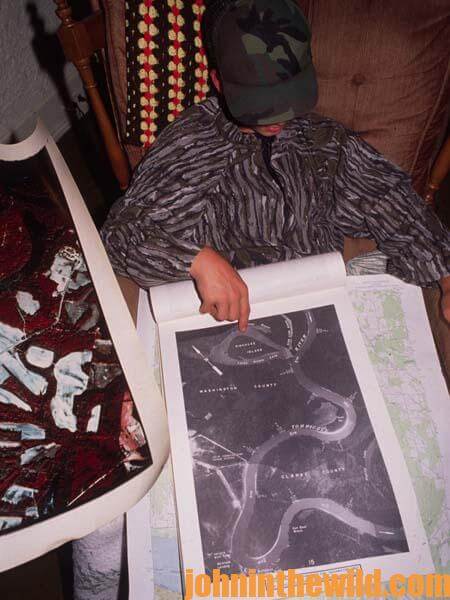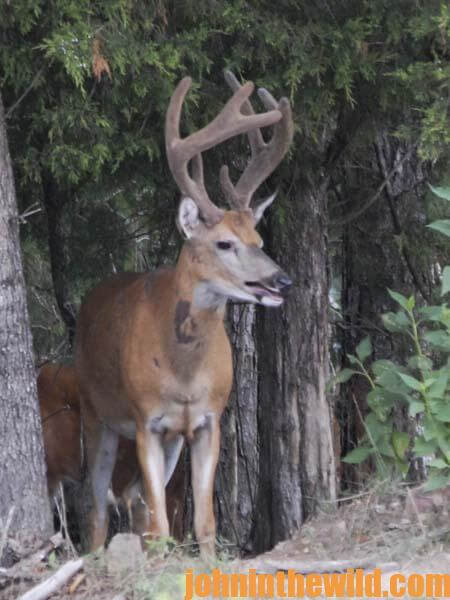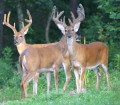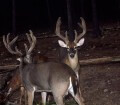John’s Note: This week we’re learning secret tactics used by trophy deer hunters before they set foot in the woods – to locate the terrain and cover that holds the basket-racked bucks. You can find the buck you want this season or at least learn where he should be while studying on your kitchen table this summer. Many hunters spend too much time walking around in the woods and not enough time learning how to hunt their areas and identifying where bucks move. An aerial photo and a topographic map can show you where deer are most likely to appear, how to increase your hunting time and how to decrease your scouting time.
 “Once I determine what land looks like from an aerial photo, the next landmarks I instinctively search for on the photo are the natural funnels on the property I hunt,” Bo Pitman, formerly of White Oak Plantation in Tuskegee, Alabama, who now lives and hunts in the West primarily, says. “I’m looking for places like a field that corners into a creek with a small hardwood strip between the two, a woods road that bends into a pine plantation and any other type of natural funnel where two types of terrain come close together and leave a small corridor through which deer can pass. These natural funnels are where I’ll see the most deer movement and where the chances will be best for taking a deer on any piece of property.”
“Once I determine what land looks like from an aerial photo, the next landmarks I instinctively search for on the photo are the natural funnels on the property I hunt,” Bo Pitman, formerly of White Oak Plantation in Tuskegee, Alabama, who now lives and hunts in the West primarily, says. “I’m looking for places like a field that corners into a creek with a small hardwood strip between the two, a woods road that bends into a pine plantation and any other type of natural funnel where two types of terrain come close together and leave a small corridor through which deer can pass. These natural funnels are where I’ll see the most deer movement and where the chances will be best for taking a deer on any piece of property.”
Generally, you won’t find more than three productive funnels on any 2,000 acres of land. But you can see these funnels from an aerial photo and quickly identify the best places to hunt on that property. The birds-eye view you get with an aerial photo gives you a much better, clearer picture of the land you want to hunt and even can tell you the kinds of trees you have on the property. “Hardwoods will appear like little round blobs on an aerial photo, whereas pine trees will look smoother, like the brush strokes of a paint brush,” Pitman explains. “You can tell by an aerial photo whether the area has both pine and hardwoods, all hardwoods or planted pines by the texture of the trees on the photo.” If you’re bowhunting and plan to hunt around nut trees, the aerial photo can show you where these trees are. If you’ll be hunting pine thickets later in the season because the deer are hiding in the pines to dodge hunter pressure, the aerial photo will show you how to go to these sites.
 Although aerial photos can give you plenty of information, if you learn to use them about the land you hunt, aerial photos also can be misleading. Because aerial photos purchased from the U.S. Geological Survey are made about once every 10 years, knowing how old an aerial photo is can tell you how reliable the information you see is. Perhaps the land has been timbered, the fields have been allowed to grow up, agricultural practices have been implemented, or a tornado or a windstorm has blown down numbers of trees since the aerial photo was made. Then your aerial photo will not have the quality and precision of a recent photo. Sometimes hunters charter private planes and fly over their hunting areas, marking photographs before deer season and after deer season to give them up-to-date maps to study and use for making their hunt plans. Although chartering a small plane to photograph your hunting area seems a great expense, if you calculate the number of days you must spend in the woods to obtain this same information, you’ll see the cost is negligible.
Although aerial photos can give you plenty of information, if you learn to use them about the land you hunt, aerial photos also can be misleading. Because aerial photos purchased from the U.S. Geological Survey are made about once every 10 years, knowing how old an aerial photo is can tell you how reliable the information you see is. Perhaps the land has been timbered, the fields have been allowed to grow up, agricultural practices have been implemented, or a tornado or a windstorm has blown down numbers of trees since the aerial photo was made. Then your aerial photo will not have the quality and precision of a recent photo. Sometimes hunters charter private planes and fly over their hunting areas, marking photographs before deer season and after deer season to give them up-to-date maps to study and use for making their hunt plans. Although chartering a small plane to photograph your hunting area seems a great expense, if you calculate the number of days you must spend in the woods to obtain this same information, you’ll see the cost is negligible.
In the West, an aerial photo is not as critical to success as it is in the East. There is little timber in some places in the West and more mountains and valleys, therefore a topo map may be a better hunting tool for pinpointing deer there. However, a topo map also is very useful when hunting deer in the East in heavily-timbered terrain. Although you may be able to tell the timber types and the general lay of the land from an aerial photo, you may not be able see how the drainage system in the area creates bottoms and contour. But a topo map will give you that information.
 Using both aerial photos and topo maps will enable you to scout much quicker and more effectively. The photos and maps you use to hunt your property are much like your ticket to a football game. The information on the ticket tells you where the stadium is located, has a diagram on the back that shows you where the section gate is that you must use to enter the stadium and also denotes which section you are supposed to sit in, but doesn’t show you your specific seat. I have known hunters who have studied aerial photos and topo maps and have walked into a natural funnel, a hardwood bottom or the edge of a field and have bagged a buck without ever actually scouting the land on foot – but these instances are rare.
Using both aerial photos and topo maps will enable you to scout much quicker and more effectively. The photos and maps you use to hunt your property are much like your ticket to a football game. The information on the ticket tells you where the stadium is located, has a diagram on the back that shows you where the section gate is that you must use to enter the stadium and also denotes which section you are supposed to sit in, but doesn’t show you your specific seat. I have known hunters who have studied aerial photos and topo maps and have walked into a natural funnel, a hardwood bottom or the edge of a field and have bagged a buck without ever actually scouting the land on foot – but these instances are rare.
To get John E. Phillips’ Kindle eBooks and print books on hunting deer, “How to Hunt and Take Big Buck Deer on Small Properties,” (John’s latest book), “How to Hunt Deer Up Close: With Bows, Rifles, Muzzleloaders and Crossbows,” “PhD Whitetails: How to Hunt and Take the Smartest Deer on Any Property,” “How to Take Monster Bucks,” and “How to Hunt Deer Like a Pro,” or to prepare venison, “Deer & Fixings,” click here.










